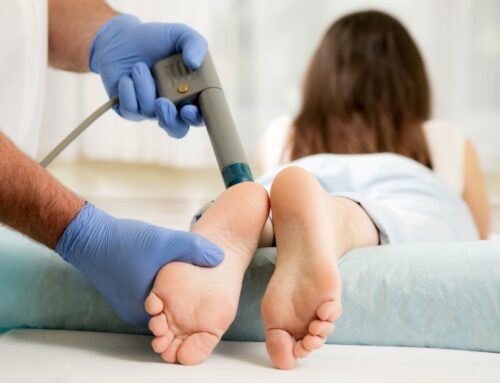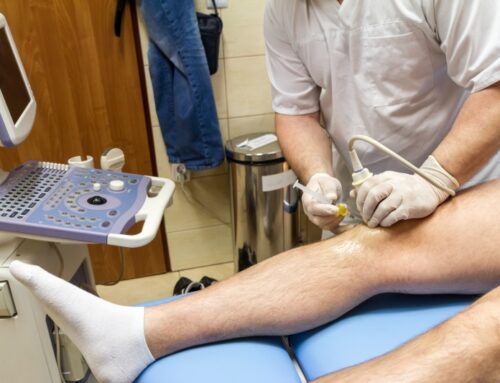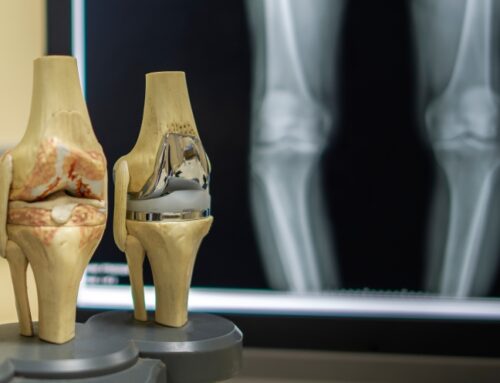Posterior heel pain is a common condition affecting the general population. When doctors talk about posterior heel pain, they mean pain at the back rather than under the heel. There are different causes of back of heel pain, including heel bursitis, Haglund’s deformity, Achilles tendon bursitis and tendonitis, plantaris tendon, and calcaneal (bone spur). So how can we find the exact cause, and how do we treat it?
Anatomy of the back of the heel

You might think the anatomy at the back of the heel is simple, but it’s a little complex.
First, you have the large heel bone called the calcaneus. Attached to this bone from above is the large Achilles tendon. Protecting the tendon are two heel bursae: the large retrocalcaneal bursa under the Achilles tendon and the more superficial retro-Achilles bursa sitting on top of the tendon near the skin. Next, a large fat pad called Kager’s fat pad sits next to the deeper bursa. Finally, the back of the ankle joint sits between the tendon and the fat pad. With such complicated anatomy, is it any wonder we have problems such as Achilles bursitis, tendonitis, or heel bursitis?
Sources of back of heel pain, including heel bursitis
Pain at the back of the heel is commonly due to the following causes:
Heel bursitis
Bursitis of the heel is usually thin-walled sacs of fluid that protect the Achilles tendon. However, in cases of sudden excessive stress on the bursa, such as a sudden change in activity or wearing ill-fitting shoes, these bursae become irritated or swollen. This condition is known as heel bursitis.
Achilles tendonitis
The Achilles tendon can become swollen and irritated at the heel bone or calcaneus insertion. You need to appreciate that the Achilles tendon and heel bursa are closely related, so swelling of the tendon is often associated with swelling of the bursa.
Calcaneal (bony) spur
A bone spur can form in the Achilles tendon at the attachment to the heel bone. This bony prominence can develop over time. The presence of bone in the tendon is irritating and can cause associated tendonitis and bursitis.
Other causes of pain at the back of the heel include:
- Haglund’s deformity
So how do we diagnose back of heel pain?
Diagnosis can be difficult, and multiple conditions can often exist simultaneously. For example, the factors that irritate the bursa can also cause swelling in the Achilles tendon. Moreover, the formation of a bony spur, also called Haglund’s deformity, can irritate the bursa.
In general, we use a combination of clinical assessment and imaging, such as ultrasound, to diagnose back of heel pain correctly. Features that would make us think about heel bursitis or Achilles tendonitis include:
- Warming up pain at the back of the heel
- pain in the morning on waking
- swelling at the insertion of Achilles to the heel bone, also known as a painful bump on the heel
- pain while wearing tight-fitting shoes
Ultrasound looks at the structures that can be affected, such as heel bursitis, Achilles tendonitis, heel bump, and Haglund’s deformity. However, we only use MRI if we think the cause of heel pain is related to other structures, such as the back of the ankle joint (os trigonum) or the heel bone (cysts).
Heel bursitis or plantar fasciitis: how to differentiate the two
These two conditions occur close together in the heel. However, the location of the pain gives a clue to the cause. Plantar fasciitis causes pain under the heel, while heel bursitis causes a painful bump on the heel.

Heel bursitis treatment
First, you should start with simple treatments such as changing your footwear, using gel pads to reduce pressure, heel lifts in shoes, and applying anti-inflammatory measures (such as ice and ibuprofen gel). The best shoes for heel bursitis are comfortable and supportive shoes for the heel and mid-arch. In addition, the shoe heel should not compress the Achilles bursitis as direct pressure can worsen bursitis. Sometimes, a doughnut pad on the heel can stop direct pressure on the heel.
Second, a rehab program to strengthen the calf muscle is essential. You should see a therapist interested in treating heel pain, including heel bursitis. Remember that heel bursitis is often associated with Achilles tendonitis, so treatment of both is helpful to improve outcomes.
Third, adjuncts to a rehab program are helpful for Achilles bursitis and include shockwave therapy and GTN patches. In particular, GTN patches are beneficial for improving pain and reducing bursal swelling.
Finally, you must appreciate that conditions such as heel bursitis or Achilles tendonitis take a long time to improve. Therefore, you need to set your expectations accordingly.
Heel bursitis injection: Is it a good idea?
Maybe. Heel bursitis is an inflammation of the bursa, and cortisone is a potent anti-inflammatory. So, we think injecting cortisone into a bursa will reduce pain and inflammation. However, we also know that cortisone has side effects, including weakening tendon structure and thinning of the skin. So, overall, we think that the risk of a cortisone injection is perhaps too high for most people with heel bursitis.
So, are there other injection options if cortisone is a high risk for Heel bursitis?
Yes, there are other injection options for tendonitis. We use sclerosant drugs such as high-concentration sugar or polidocanol to target nerves surrounding the tendons and bursa. We know that abnormal growth of nerves occurs in heel bursitis or Achilles tendonitis. These nerves follow blood vessels, and we can see blood vessels clearly on ultrasound. We can target and destroy the nerves that cause pain by injecting the blood vessels on ultrasound.
Dr Masci has written a paper summarising the effectiveness of injections in tendonitis.
Is surgery a good option for heel bursitis?
Overall, we think the results of surgery are, at best, unpredictable.
We strongly advise avoiding surgery unless you have failed all other treatments, including rehab and injections. Options for surgery include removal of the bursa and Haglund’s deformity to removal, debridement, and reattachment of the Achilles tendon. Some people do well, but others struggle with persistent pain after surgery. In addition, other risks include wound breakdown and infection.
Other commonly asked questions about heel bursitis:
Can you get gout at the bottom of your heel?
Yes, but it’s rare. Often, gout presents as sudden pain with swelling and redness. Unlike Achilles tendonitis, it is usually unrelated to exercise.
Can I run with heel bursitis?
Yes, but only if the Achilles tendonitis pain remains mild and stable. Generally, we recommend you modify running simultaneously as treatment.
Do heel lifts help heal bursitis?
Yes, we think so. A recent study found that using a 2 cm heel lift in shoes improves pain of insertional Achilles tendonitis after only two weeks. The most significant improvements occurred in patients with calcification or Haglund’s deformity. We think heel raises work by increasing the ankle joint range of motion.

Final word from Sportdoctorlondon about heel bursitis
Heel bursitis can be a challenging condition to treat. Overall, we suggest you start with simple and non-invasive treatments first. Then, move on to invasive treatments such as injections only if needed. Finally, avoid surgery in almost all cases.








Lorenzo
It’s velia from Brisbane. Tony D’ARIENZO wife. I am a runner with a problem heel. I googled to see what it is I might have snd your article came up. Great read and very informative. I think I have bursitis and perhaps Achilles tendinopathy.
It’s so painful
Hope you are well
Velia
Hi Velia, Good to hear from you. Yes, I suspect you have insertional Achilles tendinopathy. Simple management strategies work best – avoid tight shoes, calf exercises and topical anti-inflammatories.
LM
I have a white lp on the back of my foot I use to work on concrete floors wearing steal toes shoes .I m no longer working there so I do another job that I be on my feet all the time wear I wore crops shoe almost every day the one you just slide your feet in and I wore low flat heels shoes I start noticing that it was hard for me to walk on my feet so I start wear thick rubber heel tennis shoes that helped and sometimes I put shoe pads in that helps as well but the lump is still there.what should I do any suggestions.
Please read my blog for suggestions. I suggest you avoid heel compression – which means avoiding tight-fitting shoes.
LM